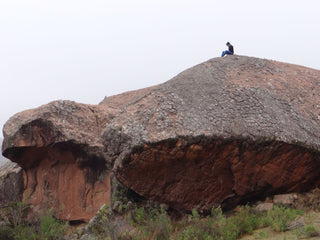By Lucia Berrios.
Today I am going to tell you a little about Bolivia. As you know, Bolivia is located in the heart of South America and is mainly known for the Lake Titicaca and the great Uyuni Salt Flats. They are undoubtedly very beautiful places, but they are not the only attractions in our country. What you might not know about Bolivia, is that it is a super diverse country and an ideal place for those who are looking for an adventure in the middle of a natural paradise rich in culture and history as well. When all this coronavirus crisis passes and people can travel again, there will be a greater tendency to make more sustainable tourism trips, visiting outdoors, avoiding crowded destinations and seeking to minimize impacts on the environment and local cultures, exactly what Bolivia offers to the world.
So… I decided to write a little about some not so well-known corners of Bolivia, where it is ideal to make these types of trips:
Torotoro National Park

Torotoro is considered the first geo-park in Bolivia, thanks to the more than 3,500 dinosaur tracks found in this place. Can you imagine? You can really see footprints everywhere! From traces of brontosaurs to tyrannosaurs!
Another of the main attractions is El Vergel, a canyon over 300 meters deep and from where you have an amazing view. When descending (like 1,000 stairs!), waterfalls can be seen cascading from the rocks. It is a unique place that fills you with energy.
 ToroToro is located north of Potosí, but the main entrance is through Cochabamba. It is at 138Km. by road from the city and can be reached in about 4 hours.
ToroToro is located north of Potosí, but the main entrance is through Cochabamba. It is at 138Km. by road from the city and can be reached in about 4 hours.
I always wanted to visit Torotoro and last year I had the opportunity to do so, thanks to my work! The ideal is to take 3 to 4 days to visit its main attractions. The minimum altitude of the protected area is 1,600 meters above sea level and the maximum height is 3,600!
Ciudad de Itas (Stone city) is another great place to visit! It is the highest part of the National Park and can be visited in half a day (although we took all day and it was worth it!). During this hike we saw huge labyrinths of rocks and caves with different shapes. The best part was, where the stone “cathedrals” were located, small caves shaped like bells… beautiful!

The last day we went to the Umajalanta Cavern. To be honest, I was terrified to enter the cavern, but I’m glad I did! For this, you need to have a helmet and a flashlight (you can rent them on site) and, if possible, ropes. Something that is also important, is not to be afraid of the dark! Once inside the caves you can see stalactites and stalagmites, and even a lagoon where blind fish live.

Torotoro - Vergel Canyon
Torotoro has many more attractions, and is an ideal destination for those who enjoy outdoor activities, hikes and you can even travel with children that are crazy about dinos! Just to give you an idea… in the main square of the town, instead of finding the classic statue of someone important in history, there are huge dinosaurs!

Sajama National Park
Sajama is located in Oruro, about four hours to the south of La Paz and on the border with Chile. From La Paz, almost the entire road is paved and it takes about 5 hours to get there. Along the way is the town of Curahuara de Carangas. It is worth stopping here to visit its church, built between 1587 and 1608 and known as the “Sistine Chapel of the Andes”.

All interior walls and ceilings are oil painted in a mannerist style and express Old Testament biblical passage. It’s pretty cool to see something like this in the middle of the highlands!

To visit the Sajama National Park I recommend you to consider a 2 to 3 day trip. Within the protected area you can see the Sajama volcano (inactive), which has the highest peak in the country (6,545 masl) as well as several high Andes lagoons, my favorite being the Huayñakota lagoon where we observbed hundreds of colorful flamingos.

Throughout the protected area you can see forests of “queñuas”, that are small trees that survive at 5,200masl, considered by many to be the highest forest in the world. In the surroundings, and if you are lucky, you can see vicuñas, vizcachas (a rodent similar to the hare, about 60cm long, with a long tail) and even condors! In Sajama there are also many hot springs in natural pools and some geysers that sporadically spout water due to the volcanic activity in the area. Many of its visitors are mountain climbers, who seek the challenge of ascending a peak of more than 6,000masl.
Sudeste Chiquitano

The Chiquitano region is located in Santa Cruz and includes the route from San José de Chiquitos (3 hours by car from the city) to Roboré (5 ½ hours from the city). I recommend you to consider at least 3 days to visit this area.

Let’s start with San José de Chiquitos: its main attraction is its church, which is part of the circuit of the Jesuit missions, almost all of which are declared cultural heritage of humanity by UNESCO (including this one). This church is one of my favorites, since it is the only one built with stone and lime and has a very special facade.
During the restoration of these churches, more than 5,000 sheets of sacred music written between the 17th and 18th centuries were found. Until today, local community members learn to play instruments such as the violin from a very young age and since 1996, every 2 years, the International Baroque Music Festival has been held throughout the missionary circuit.

I am really lucky because I was able to attend the festival in 2014 and it is something really unique! Just imagine to see the inhabitants (especially children!) and international artists playing this beautiful music in the well-restored churches… it’s like a journey back in time!

About 2 ½ hours from San José is the community of Santiago de Chiquitos. The best of this place is the Tucavaca Valley, which has an ecotourism trail where you can appreciate the nature of the Chiquitano Dry Forest. After walking for about 3 to 4 hours (a steep climb!), you will be rewarded at the final viewpoint… known as the “antesala del cielo” (anteroom of heaven). You’ll enjoy a most spectacular view, very well complemented by massive stone towers. It’s definitely beautiful!This place was one of the most affected by the fires of 2019, but the nature is incredible and everything bloomed and grew super-fast again. I recommend you to do this walk in the morning, so that in the afternoon you can continue towards Roboré, making a stop in Aguas Calientes. There’s a nice lagoon of about 5Km. long, with water that has a temperature between 41 and 45°C (I recommend you to visit it in winter!). Inside the lagoon, you literally feel the earth absorb your body, while you feel like delicious massages by the boiling water.

This place was one of the most affected by the fires of 2019, but the nature is incredible and everything bloomed and grew super-fast again. I recommend you to do this walk in the morning, so that in the afternoon you can continue towards Roboré, making a stop in Aguas Calientes. There’s a nice lagoon of about 5Km. long, with water that has a temperature between 41 and 45°C (I recommend you to visit it in winter!). Inside the lagoon, you literally feel the earth absorb your body, while you feel like delicious massages by the boiling water.

Lucia Berrios | Tourism Expert | Travel Consultant at SendasAltas / La Paz on Foot
Lucia was born and grew up in the fascinating city of La Paz and studied tourism at university. She loves Bolivia and sharing its wonders with visitors and enjoys traveling and searching for new experiences whenever she can.
“I specialize designing and operating adventuresome travel experiences in La Paz, Sucre, Potosi, the sacred Lake Titicaca, the dazzling Uyuni Salt Flats and the lowland rainforest regions of Beni and Santa Cruz as well. I also organize multinational trips, such as Perú-Bolivia-Chile. I especially enjoy organizing tours that allow our visitors to interact with the people of Bolivia in respectful ways, there is so much to learn about this place of the world and they are always happy to share!”



Pamela
Thanks to our dear friend Lucia for this collaboration and being able to show a little of our beloved Bolivia together.
😀
James Brunker
Great to see Torotoro and Sajama getting some attention! 2 spectacular national parks that are among my fabourite places in Bolivia for photography and deserve to be better promoted than they are!